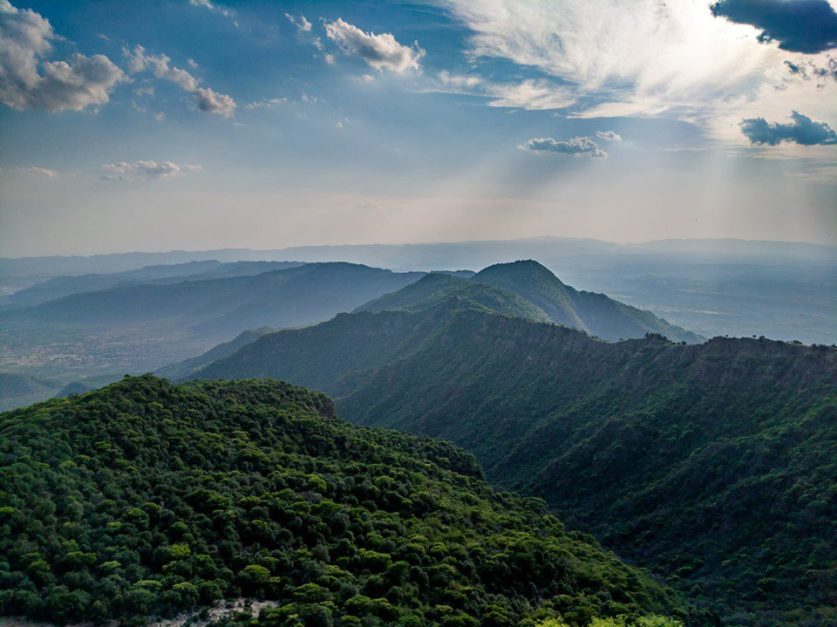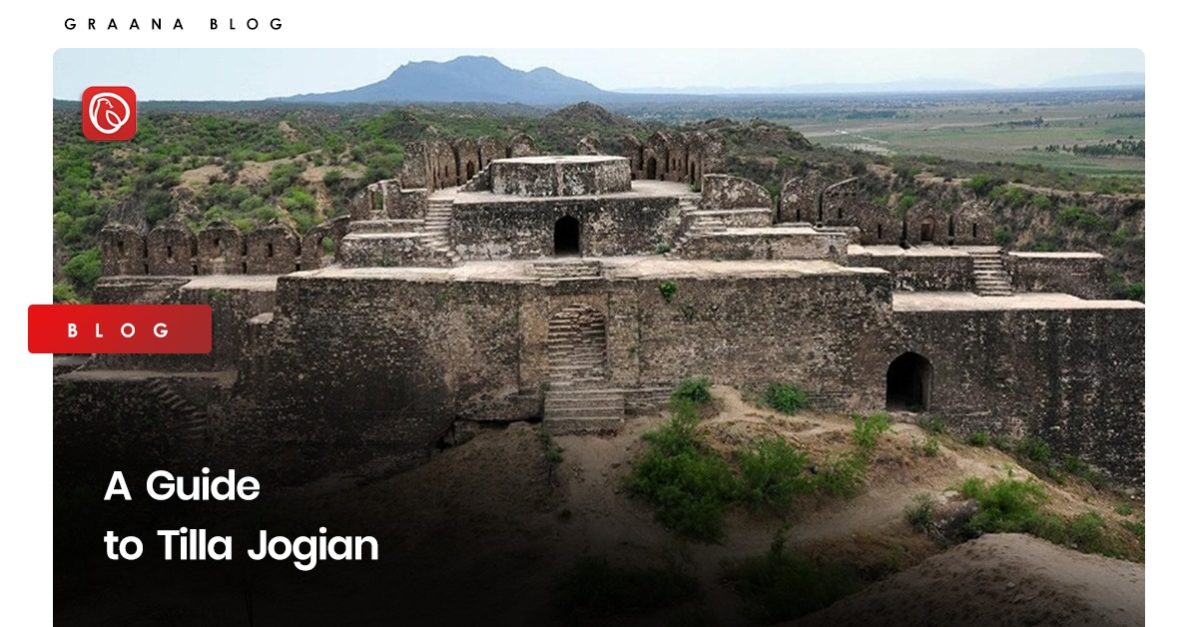Pakistan is a diverse country known for its vibrant culture, friendly people, and historical sites. If you are fond of historical sites and old architecture, Tilla Jogian is the perfect place to visit.
It is a complex of an ancient Hindu temple and monastery located on the summit of the Tilla Jogian Mountain, which is located in the Salt Range in Pakistan’s beautiful Punjab area.
Because of this, it is one of the best places to visit in Pakistan. This location is unquestionably a natural draw as soon as one starts to appreciate the profoundly quiet and uninterrupted seclusion that comes with being outdoors.
Overview of Tilla Jogian

This mountain, which is referred to as Tilla Jogian, is revered by both Hindus and Sikhs. In Punjabi, the word for “mountain” is “Tilla,” and the word for “yogi” is “Jogian.”
Before the Partition, this location was home to hundreds of Jogis and was revered as the most significant Jogi pilgrimage site in all of Punjab. The location known now as Tilla Jogian formerly housed a Brahminical institution that was encircled by sizable residential neighborhoods.
History of Tilla Jogian
According to mythology, Hindus have been making the journey to Tilla Jogian for at least the past two thousand years. It is believed that the structure was constructed in the first century before the common era.
Tilla Jogian served as the epicenter of the ascetic order known as the Kanphata Jogi, which was established by Guru Gorakhnath. Members of this order had their ears pierced.
Guru Nanak, the founder of the Sikh religion, came to Tilla Jogian in the early 1500s to meditate for a period of forty days. He was drawn here because of the significance of Tilla Jogian as a Hindu pilgrimage destination.
The mighty and well-known yogi Balnath was honored by a trip from the Mughal Emperor Akbar, who made a visit to the “Shrine of Balnath.” According to his biographer Abul Fazal, Akbar was astounded by how old the place was and that the shine was “so old” that its origins were unknown.
The monarch Jahangir, who ruled throughout the 17th century, was also known to have visited the temple complex. After the Mughal empire was defeated, the Pashtun monarch Ahmad Shah Abdali led a series of assaults into Punjab. During one of these incursions, he ransacked the building and stole its contents. After Abdali was killed, the facility was quickly rebuilt after it was destroyed.
In order to commemorate Guru Nanak’s visit, Maharaja Ranjit Singh constructed a small monument and a pond that was surrounded by stones. The monument’s purpose was to point out the location of the exact spot where it is said that Guru Nanak meditated.
Location of Tilla Jogian
On the Potohar plateau, approximately 25 kilometers to the west of the cities of Jhelum and Dina, is where you will find the Tilla Jogian complex. The complex is found in close proximity to the Jhelum River as well as the Grand Trunk Road, which was an old trade route that linked Central Asia and India.
Tilla Jogian is located close to the Rohtas Fort as well as the Katas Raj Temples, which are both significant Hindu pilgrimage sites. The Tilla Jogian complex is near Pakistan’s Salt Range, more specifically on the summit of a mountain with the same name.
The temples are situated at an elevation of 975 meters (3200 feet), close to the peak of the mountain, which results in a temperature that is both cooler and wetter in comparison to the climate of the plains of Punjab.
How to visit Tilla Jogian

Visitors have the option of using either the conventional footpath or the Jeep track to get there. The traditional route starts in a town at the foot of the mountain and then weaves its way up the steep slope of the peak. The ascent must be made through foliage, rock, and brambles, which requires climbing abilities in addition to stamina.
Another route connects the two sides of the Kaghan River; however, the road is no longer there; thus travelers will have to navigate the riverbed instead. The path leads to the Rohtas Fort, one of the most famous forts in Pakistan, which was built by Sher Shah Suri after he deposed the Mughal emperor Nasir al-Din Humayun during his brief but fruitful rule.
The trail climbs 3,200 feet by this beautiful entryway and another at the further end until reaching the peak of the solitary peak on which the monastery is perched.
Structure of Tilla Jogian
At the very peak of the mound, there are three distinct clusters of aging buildings. The remains of twelve temples, a shrine, and a monastery can be found among them. All of these structures are in ruins.
The historic site is additionally embellished with a central water tank and a well that was constructed in the Central Asian style during the Mughal period. The square water tank, which was constructed for the purpose of storing rainwater collected from the catchments region, features 10 stairs on each of its four sides.
A ramp leading up from the floor in the northern wall, complete with semi-hexagonal minarets and walls on both sides, is also visible at this location.
The highest point of each minaret is occupied by a kiosk, which is then covered by a dome that contains flutes and ribs and is topped off with a lantern. This section of the tank is distinguished by the presence of ladies’ bathers and cross-legged deities, both of which are ensconced behind a wall that divides the eastern parapet.
On the highest point of the hill is a shrine that honors Baba Guru Nanak’s visit; some of the shrine’s destroyed structures may be seen there. In addition, there is a cave beneath this structure. The isolated collection of crumbling buildings that make up the monastery can be found at the highest point in the woodland.
The majority of its structures are derelict and roofless hulks at this point. The temple dedicated to Lord Shiva, on the other hand, has a roof and is, for the most part, unharmed.
Stories Associated with Tilla Jogian

- A version asserts that the renowned romantic hero Ranjha, whose heart was broken when Heer was married off to someone else against her will, joined the brotherhood of jogis right here at this precise location once he found out about the marriage. In order to become known as the “faqir of Heer,” he had to journey all the way from Sial in Jhang, which is the location of Heer of Sialan’s hamlet, to Tilla Jogian, which is located away from Jhelum.
- Another legend associates Tilla Jogian with Abu Rehan Al-Bairuni, a mathematician and scholar who lived during the time of the Mahmood Ghaznavi dynasty and is said to have spent thirteen years in this region in order to determine the circumference of the world. In order to complete this remarkable scientific feat, which is still considered to this day to be the accurate measurement of the circumference of the earth, he first sat on Tilla Jogian and then moved on to the Nandna Fort. In his famous book, Kitabul Hind, the Afghan scholar, historian, and philosopher, who was considered a rebel by the kings of Ghazna, chronicled his journeys to the Salt Range. Ghazna was located in what is now known as Afghanistan.
For more informative content, visit Graana blog.




